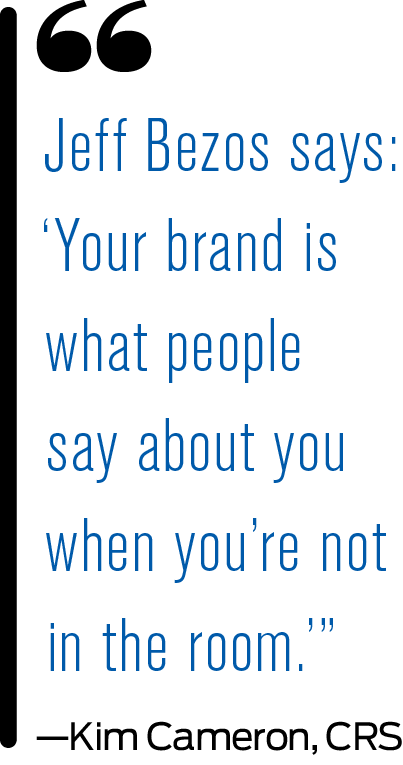By Kim Cameron, CRS
Now that we all have become comfortable with using multiple media channels, some of us are “out there” with a business persona on LinkedIn and in mail pieces, a fun persona pub crawling on Instagram and a political persona on Twitter. While being a businessperson doesn’t mean that you have to shut down different aspects of yourself, it’s important to maintain a consistent brand in your public-facing media.
In the RRC course I’m teaching called “Digital Branding: Building Client Relationships,” you will find out why it’s so important to have a unified brand presence.
 One of my favorite quotes is from Jeff Bezos, who says, “Your brand is what people say about you when you’re not in the room.” So, when you’re not in the room, you need to make sure that there is consistency in your brand wherever it’s received by the public and your target audience—from a billboard to a centerfield banner at the Little League park to social media. Wherever you’re doing your marketing, your professional persona is being perceived by the public, as well as your past clients and people that know, like and trust you. That messaging—your brand—should be consistent.
One of my favorite quotes is from Jeff Bezos, who says, “Your brand is what people say about you when you’re not in the room.” So, when you’re not in the room, you need to make sure that there is consistency in your brand wherever it’s received by the public and your target audience—from a billboard to a centerfield banner at the Little League park to social media. Wherever you’re doing your marketing, your professional persona is being perceived by the public, as well as your past clients and people that know, like and trust you. That messaging—your brand—should be consistent.
In the course, we will go over the details that make up a consistent brand message, like using the same typefaces and colors in your materials, and even something so basic as having an updated headshot. (We’ve all had that experience of meeting someone whose ads we’ve seen and thought, “Is this the same person?”) Also, take a good look at your professional biography. Is it written in a third-person narrative? You might want to change “Jamie has been in business for 10 years” to “Jamie has been in business since 2012.” That way, you won’t have to update that statement every year.
To develop your brand, it begins with reviewing aspects of your personality and your business strengths.
Find your voice.
Your voice is the beginning of your brand. Are you sincere? Are you driven? Are you humorous? If you are the kind of person who would say, “We’ll treat you better than family. We argue with family. We don’t argue with clients”—you can include a statement like this in your materials to give prospects an idea of your personality.
Use your mission statement and core values.
Your mission statement should share what you do and drive the decisions you make for the direction of your business. Your core values will guide your culture and how you do business and treat your clients. When you follow your mission statement and core values, decisions become easy, and that’s what you want to share with the community. Starbucks founder Howard Schultz has said, “If people believe they share their values with a company, they will stay loyal to the brand.”
Craft your offer.
Your brand communications must also include your area—or areas—of expertise. Find the proper balance between seeming like a jack-of-all-trades and master-of-none and being pigeonholed into a narrow niche. For example, if you’re helping somebody buy a home, you don’t want them to say, “I hired someone else to list my house because I thought you only work with buyers.”
Once you’ve laid this groundwork, begin with your print media, including your buyer’s guide, listing guide and other forms. These can then be adapted into digital versions for easy distribution. And make sure your professional social media accounts reflect your brand. These don’t have to be humorless and dry, but think what you would like to see from a professional you’d consult. Would you call a tax accountant whose business Instagram shows them a little too tipsy? Use your personal accounts for personal interests and let your business accounts make your brand the star.
Kim Cameron’s Digital Marketing classroom course on branding will be held on September 28, 2022. Register today at CRS.com.
Photo: iStock.com/tudmeak








